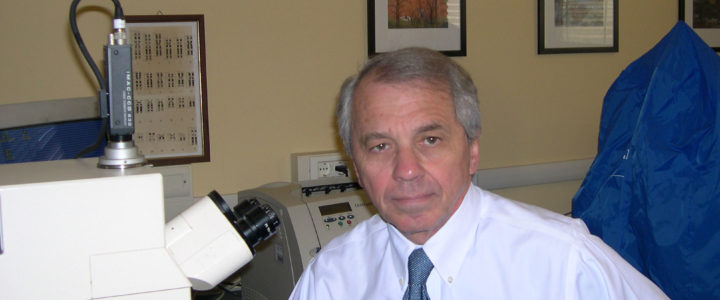With $45,000 in grants from FRAXA Research Foundation over several years, Dr. Miklos Toth of Cornell University studied epigenetics (ie factors other than the gene itself) which can determine symptom severity in Fragile X.
Read moreDisease Mechanisms
Role of Matrix Metalloproteinases (MMP-9) in Fragile X

With a $220,000 grant from FRAXA Research Foundation over 3 years, Dr. Iryna Ethell from the University of California at Riverside studied the regulation of dendritic structure by matrix metalloproteinases and other extracellular signaling pathways. This work identified a major treatment strategy for Fragile X with the available MMP-9 inhibitor, minocycline.
Read moreNovel Functions of Drosophila FMRP

With a $120,000 grant from FRAXA Research Foundation over 2 years, Dr. Thomas Dockendorff from the University of Tennessee and his colleagues were pioneers in using the power of fly genetics to understand the different functions of the fly version of the Fragile X protein.
Read moreBasic Mechanisms of Disease and Potential Therapeutic Strategies

With $245,000 in grants from FRAXA Research Foundation, Dr. Stephen Warren and his lab at Emory University studied all aspects of Fragile X syndrome, from the mechanisms of repeat expansion to high-throughput drug screens in the Drosophila model of Fragile X. The Warren lab made the original discovery of the Fragile X gene, FMR1, in collaboration with the Nelson and Oostra labs, and is recognized internationally as a leader in molecular genetics. Recent projects include establishment of induced pluripotent stem cell lines from Fragile X patients, and determination of other forms of mutation in the Fragile X gene, other than the most common trinucleotide repeat expansion.
Read moreAltered Cyclic AMP Signaling in Fragile X

With $125,000 grant from FRAXA Research Foundation over 2006-2008, Dr. Anita Bhattacharyya at the University of Wisconsin Waisman Center investigated abnormalities in cyclic AMP signaling in Fragile X syndrome. Results published.
Read moreGlutamate Metabolism in Fragile X Mouse Brain

With a $95,000 grant from FRAXA Research Foundation over 2 years, Mary McKenna at the University of Maryland studied the role of metabotropic glutamate receptors (mGluR) and how they affect other cells and pathways.
Read moreIn Vivo Imaging of Synaptic Abnormalities in a Mouse Model of Fragile X Syndrome

With an $85,000 grant from FRAXA Research Foundation over 2007-2008, Dr. Wen-Biao Gan and his team at New York University studied in-vivo protein development using imaging in mouse models to determine when pre- and postsynaptic structural plasticity occurs to target and when it develops abnormally.
Read moreSleep and Circadian Rhythms in Fragile X Mutant Drosophila

With an $80,000 grant from FRAXA Research Foundation over 2 years, Dr. Ravi Allada and his team studied at Northwestern University sleep behaviors in Fragile X fruit flies. These fruit flies are useful for several important reasons; not only do they have a good cognitive phenotype, they also have a clear disturbance of circadian rhythms. This is an important model for human hyperactivity and sleep disorders, and this group studied the underlying mechanisms in an effort to find treatments for the human conditions.
Read moreAMPAkines and BDNF in Fragile X: UCI Researchers Restore Memory Process in Fragile X

With a $104,498 grant from FRAXA Research Foundation from 2003-2008, Dr. Julie Lauterborn at the University of California has done several studies on dentritic spines and finding treatment targets for memory retention in Fragile X mice.
Read moreDevelopment of the Fragile X Brain: Cellular Processes Regulated by FMRP During Development

With a $120,000 grant from FRAXA Research Foundation over 2 years, Dr. Peter Kind and his team at the University of Edinburgh will study the way FMRP affects and is affected by cortical development.
Read moreTargeting the Role of Group 1 Metabotropic Glutamate Receptors

With a $40,000 grant from FRAXA Research Foundation in 2008, Dr. Huibert Mansvelder and his team at the University of Amsterdam studied the role of different receptors and their reactions to drug compounds.
Read moreEffects of Alternative Splicing at FMR1 Exon 15 on Understanding Fragile X Syndrome

With a $118,500 grant from FRAXA Research Foundation from 2007-2008, Dr. Robert Denman and his team at the New York State Institute for Basic Research studied protein splicing, specifically looking at exon 15-encoded residues of of FMPR.
Read moreMolecular Basis of Fragile X Syndrome: Genetic Modeling in Zebrafish

With a $52,500 grant from FRAXA Research Foundation in 2008, Dr. Robert Richards and his team from the University of Adelaide studied zebrafish models and embryo development abnormalities to search for treatment targets.
Read moreIn Vitro Reactivation of the Fragile X Gene

With a $60,000 grant from FRAXA Research Foundation, Dr. Giovanni Neri and his team at Universita Cattolica del S. Cuore explored reactivation of the FMR1 gene and characterization of cell lines with unmethylated full mutation.
Read moreFMRP-MAP1b RNA Interactions in Fragile X Syndrome

With a $95,000 grant from FRAXA Research Foundation from 2006-2007, Dr. Mihaela Mihailescu and her team at Dusquesne University studied the relationship between FMRP, RNA sequences, and G quartet structure. Results published.
Read moreRegulation of Group I Metabotropic Glutamate Receptor Trafficking in Fragile X

With an $83,500 grant from FRAXA Research Foundation in 2005 and 2007, Dr. Anna Fracesconi at Albert Einstein College studied the patterns and pathways of different receptors related to Fragile X.
Read moreDecreased Excitatory Drive onto Parvalbumin-Positive Neocortical Inhibitory Neurons in a Mouse Model of Fragile X Syndrome

With an $80,000 grant from FRAXA Research Foundation over 2006-7, Drs. Jay Gibson and Kimberly Huber at the University of Texas at Southwestern examined if the defected inhibitory neurotransmission was a primary or secondary symptom of Fragile X to determine where future treatment targets should be focused.
Read moreBaclofen: GABA(B) Receptor Supersensitivity and Normalization of Behavioral Abnormalities by Various GABA(B) Agonists Including Baclofen in FMRP Deficient Mice

With $110,000 in grants from FRAXA Research Foundation over several years, Dr. Miklos Toth from Cornell University discovered increased startle response in Fragile X mice and that baclofen can correct this phenotype.
Read moreExperimental Compound FRAX486 Reverses Signs of Fragile X in Mice

With an $81,000 grant from FRAXA Research Foundation from 2005-2006, Dr. Susumu Tonegawa and his team at MIT studied the enzyme PAK to determine how it could be used for a treatment target. Results published.
Read moreProtein Synthesis in Interneurons in Fragile X Mice

With a $100,000 grant from FRAXA Research Foundation from 2004-2006, Dr. Oswald Steward and his team at the University of California studied protein synthesis alterations in Fragile X mice in the brains’ interneurons.
Read moreTherapeutic Interventions in FMR1 Knockout and Transgenic Mice: Role of the FMR1 Gene

With a $229,000 grant from FRAXA Research Foundation in 2006, Drs. Richard Paylor, David Albeck, and Francis Brennan at the Baylor College of Medicine found that, in mice as in humans, the level of Fragile X protein in brain cells plays a prominent role in determining levels of activity and anxiety.
Read moreSplicing Variations of the Fragile X Gene

With an $80,000 grant from FRAXA Research Foundation from 2005-2006, Dr. David Morris and his team at the University of Washington aimed to understand the variation in distribution and function of FMRP isoforms, sought to identify isoforms of FMRP in mouse brain, and define the expression pattern of these versions of the protein.
Read moreExamining the Amygdala in Mouse Models of Fragile X

With a $63,000 grant from FRAXA Research Foundation in 2006, Dr. Joseph LeDoux and his team at New York University studied the role of the amygdala in Fragile X syndrome using mouse models.
Read moreSocial Deficits in Fragile X Syndrome: Do Gene-Gene Interactions Play a Role?

With a $100,000 grant from FRAXA Research Foundation from 2005-2006, Drs. Jean Lauder and Sheryl Moy at the University of North Carolina looked for gene-gene interactions in Fragile X syndrome.
Read moreMetabotropic Glutamate Receptor Function in Fragile X Knockout Mice

With $143,000 in grants from FRAXA Research Foundation from 2004-2006, Drs. Walter Kaufmann, Richard Huganier, Paul Worley, and David Lieberman at Johns Hopkins University studied the molecular dynamics of mGluRs in areas involved in cognition in the Fragile X knockout mouse.
Read more
